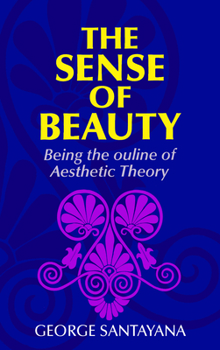The Sense of Beauty
Select Format
Select Condition 
Book Overview
It is remarkably appropriate that this work on aesthetics should have been written by George Santayana, who is probably the most brilliant philosophic writer and the philosopher with the strongest sense of beauty since Plato. It is not a dry metaphysical treatise, as works on aesthetics so often are, but is itself a fascinating document: as much a revelation of the beauty of language as of the concept of beauty.
This unabridged reproduction...
Format:Paperback
Language:English
ISBN:0486202380
ISBN13:9780486202389
Release Date:June 1955
Publisher:Dover Publications
Length:192 Pages
Weight:0.58 lbs.
Dimensions:0.4" x 5.4" x 8.5"
Customer Reviews
2 ratings
Excellent
Published by Thriftbooks.com User , 21 years ago
The philosophy of Santayana is remembered mostly by his theory of aesthetics, which is discussed in detail in this book. His aesthetic theory is basically subjective, or "psychological", and if viewed from a contemporary standpoint, somewhat at odds with current developments in neuroscience, but closer than most schools of Western philosophy. All philosophical theories of aesthetics are interesting to investigate from the standpoint of comparing them to what is said about the human aesthetic faculty in modern research in neuroscience. As in ethics, Santayana approaches aesthetics in three different ways, namely as the exercise of the aesthetic faculty, the history of art, and the psychological. The first two do not concern the author in the book, his attention devoted entirely to the third. His intention is to remove himself from the influence of the poets and of Plato, and find the out how ideals are formed in the mind, how objects may be compared with them, what properties are shared in beautiful things, and the process by which humans become sensitive to beauty and in turn value it. He is after a definition of beauty that explains its origin in human experience, and one that explains the human capacity to be sensible of beauty and the relation between a beautiful object and its ability to excite the human senses. The author takes a different definition of aesthetics, being one that he calls "critical" or "appreciative perception", and which results from combining a notion of criticism with that of the notion of aesthetics as a theory of perception. Santayana wanted to develop a theory of aesthetics that relies on perceptions as a judgmental, critical notion. Perceptions that are not appreciations are thus to be excluded. An aesthetic theory then deals with the "perception of values". The author's view of religion is well-known, and his atheism rare for his time. The religious imagination he says, has resulted in creations that rival those of the poets and novelists, so much so, he says, that humans believe the content of these creations to have objective reality. The ideas of these divinities are further enhanced by the realization of their natural power, with the belief in the reality of an ideal personality bringing about its further idealization, eventually spanning many human generations. History and tradition are cast by the imagination of these deities, in which peity resides and is nourished. The author of course does not excuse the God of Christianity from this, but he acknowledges the possibility that the human conceptions of Christ and Mary may in fact have real counterparts (the evidence of this not to be explored in this work). The author states that unless human nature undergoes radical change, the main intellectual and aesthetic value of ideas will come from the creative acts of imagination. If human perceptions are not connected with human pleasures, there would be no need to look at things, no interest in them at all, and
Psychological theory of beauty
Published by Thriftbooks.com User , 23 years ago
In this book, Santayana rejects the Platonic conception of beauty is an intrinsic characteristic of a thing, and argues for beauty that exists only in the mind (and senses, hence the title) of the viewer. The pleasure that beauty gives its audience is universal, but what is beautiful is not universal across audiences. That may be old hat to us, but wasn't quite so old hat in his time. Santayana enumerates various types of beauty, and relates each to the pleasure it gives its audience. Santayana even claims that some of our other preferences -- for example, for youth over age -- are fundamentally aesthetic in nature.The argument is Santayanaesque, and thus not exactly rigorous. A lot of the physiology ("Psychology is always physiological," he writes) is hokey to our "modern" medical minds. Some of the digressions seem to be just him taking the opportunity to say something clever, rather than advancing the main argument in any way. Still, Santayana is a virtuoso of putting together large, complex "big think" arguments, and he writes subtly and beautifully. This book is worth it, even if only to see Santayana doing what he does best: arguing broadly and forcefully, this time for a new conception of aesthetics.






